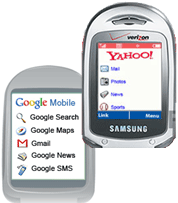The numbers are in. Mobile is frickin’ huge:
- Facebook COO Sheryl Sandberg recently told CNBC that in 2013 people spent more time on mobile than watching TV, the first time that’s ever happened.
- HSN (Home Shopping Network’s parent company) reported 59% growth in mobile sales.
- Starwood Hotels and Resorts says mobile now accounts for 42% of its web traffic.
- Yelp now gets 44% of its traffic from mobile.
I’m seeing similar things with my clients, with mobile accounting for 15% to 40% of traffic, sales, or both — along with huge growth curves.

How huge? Well, get this: Cisco projects that mobile traffic will grow 1,100% over the next four years.
As with traffic and revenues, search hasn’t escaped this trend. In fact, 100% of the increase in overall search volume comes from… yep, mobile. According to comScore (and ably pulled apart by Search Engine Land), search volume actually fell 6% in November last year. But mobile search continues to grow, and now comprises 22% of total search volume.
So, what does all this mean for your business? How can you make mobile work for search engines, your customers, and your business?
The picture’s pretty clear. Mobile matters.
A lot.
If you’re ready to make sure your site works well for mobile search and for mobile customers, I’ve got two quick tips to help you:
- Focus on customer and context
- Rebuild your website with responsive design
Let’s take a look at each of these in more detail.
Focus on Customer and Context
The typical picture of a marketing funnel suggests customers move cleanly from awareness of your brand, to interest in your products and services, through desire for a specific product to action: that magical moment when your customer takes out her credit card and gleefully hands it to you, online or offline.
This is, of course, a myth.
If the marketing funnel was ever true, it’s certainly long-dead now. Instead, your customer is continually researching and reading and struggling to reach a decision about what best will meet her needs. And, instead of sitting down at a desktop computer or reading the paper, or watching TV, she’s now conducting this research while waiting for her kids after soccer practice, in between meetings at work, or waiting for a meal at a restaurant.
Think through what your customer needs to know and where your customer will be when looking for that information.
For instance, customers using their mobile phones on the go often look for phone numbers, addresses, and directions to find their way to your business. So, make sure your phone number, address, and a link to a map appear clearly near the top of the screen. Ensure your forms don’t require tons of typing for mobile users. And explore alternative payment options like Google Wallet, NFC, or Apple’s iBeacon to ease the checkout process, whether virtual or real-world.
Rebuild Your Website With Responsive Design
This one may be a bit controversial, but hang with me for a moment.
Sure, for many businesses, it’s cheaper and easier to build a standalone mobile site than make your website responsive. Standalone sites allow you to focus on building just those few pages that address mobile customer needs, which lowers development costs and improves time-to-market.
It’s also, usually, a bad idea.
Here’s why:
- Responsive sites generally rank better for SEO. Responsive designs usually have more content and more pages, which Google tends to like. And they’re easier to update since they’re not managed separately, which increases the likelihood you will update the content. Google likes that, too.
- Responsive sites generally cost less in the longer term. Every time you update content on your main site, you also need to update it on the standalone site (unless of course, it was something no mobile user would ever care about). Maintaining two separate sets of content: Ugh. It’s inefficient, time-consuming, costly, and not terribly SEO-friendly. Again: ugh.
- Responsive sites generally work across devices more readily. This one’s not a lock, but many development shops handle different devices/screen sizes more effectively with responsive designs than on standalone sites (the very nature of responsive requires it). Again, this one’s a little more sketchy, so make sure you know how your web development team, whether in-house or outsourced, handles varying devices and screen sizes for both options.
You’ll note I said “usually” or “generally” a lot more often than I normally do. Why? Because responsive isn’t the right answer in every case (just most of them). If you’re not sure what to do, here are a few questions to help you make your decision:
- How often do you update your content? Maintaining content on two separate sites sucks (sorry, it’s a technical term). The more often you update your content, the better responsive looks.
- Do you have a specific goal for mobile users that’s different from your regular website? Few companies offer goals targeted only at mobile users, but give it some thought. If you’re one of those companies, a standalone site could be an acceptable option.
- How long do you plan to keep your current site? If you’re planning to redesign or relaunch in 6-12 months, go ahead and put up a quick standalone site for now. But if expect your site to stick around for a while, responsive probably makes more sense.
- Finally, compare prices. While responsive sites are a fair bit more upfront, the difference is often manageable enough to make them a good choice.
Conclusion
Mobile is here to stay. Its staggering growth continues to dazzle businesses and consumers alike. We’re only just beginning to see its effects on consumer behavior overall and search engines. We’ve got a long way to go.
That said, best practices exist today to ensure you show up when your customers search on mobile and to help your customers when they come to your site. The time for sitting on the sidelines with mobile is over. It’s time to get in the game.
Do you want to learn more about how to improve sales, increase conversions, and reduce the costs from your search marketing? Then take a moment to check out our Biznology Jumpstart Workshop: On-site Search Marketing Training. Taught by three Biznology search marketing experts, you’ll learn how to make your search marketing work for your business. Interested in learning more? Check it out today.





